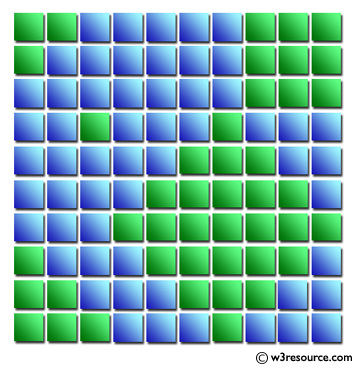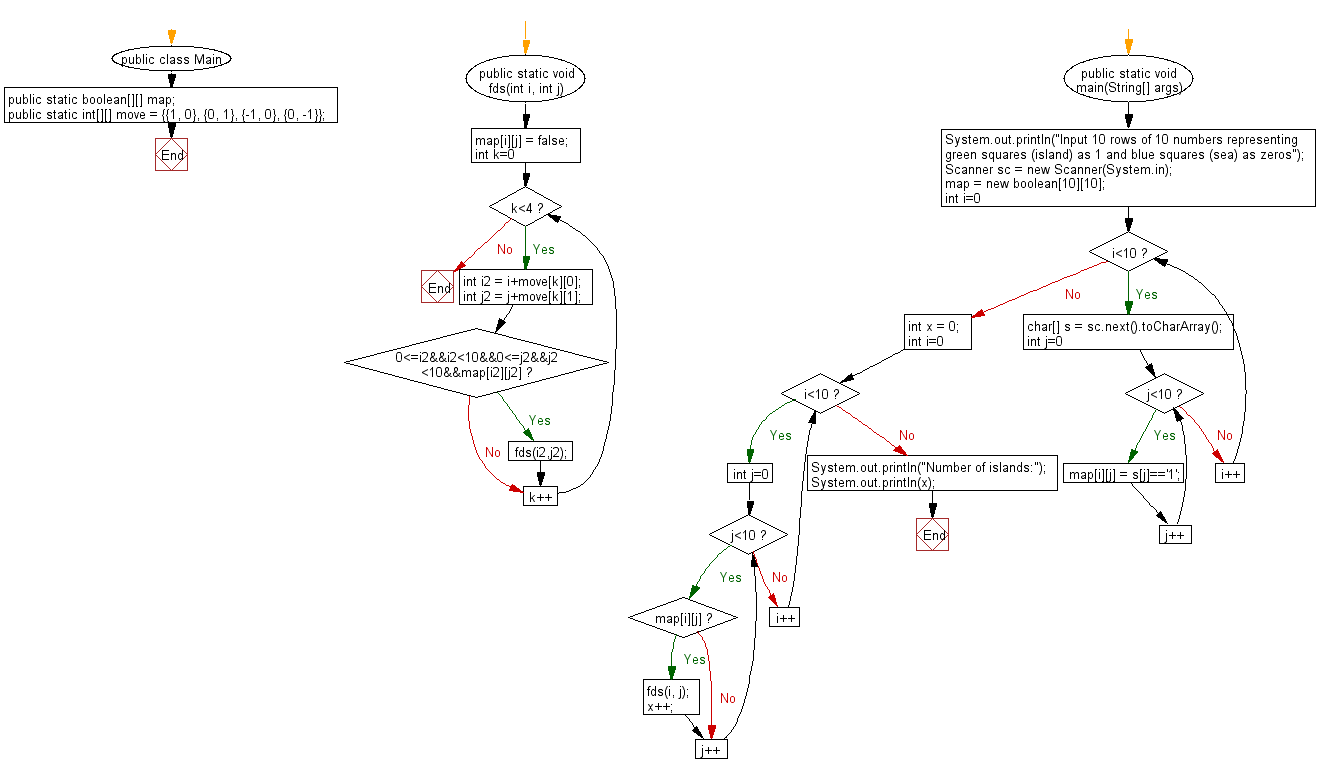Java: Read the mass data and find the number of islands
Count Islands from Grid
There are 10 vertical and horizontal squares on a plane. Each square is painted in blue and green. Blue represents the sea, and green represents the land. When two green squares are in contact with the top and bottom, or right and left, they are ground. The area created by only one green square is called an "island". For example, the figure below shows five islands.
Write a Java program to read the mass data and find the number of islands.
Input:
A single data set is represented by 10 rows of 10 numbers representing green squares as 1 and blue squares as zeros.
Output: For each data set, output the number of islands.
Visual Presentation:

Sample Solution:
Java Code:
// Importing the Scanner class from java.util package
import java.util.Scanner;
// Main class named "test"
public class test {
// 2D array to represent the map
public static boolean[][] map;
// Array representing possible moves: down, right, up, left
public static int[][] move = {{1, 0}, {0, 1}, {-1, 0}, {0, -1}};
// Recursive method to perform depth-first search (DFS) on the map
public static void fds(int i, int j){
// Marking the current cell as visited
map[i][j] = false;
// Checking neighbors in all four directions
for(int k = 0; k < 4; k++){
int i2 = i + move[k][0];
int j2 = j + move[k][1];
// Recursively applying DFS to unvisited neighbors within the map boundaries
if(0 <= i2 && i2 < 10 && 0 <= j2 && j2 < 10 && map[i2][j2]){
fds(i2, j2);
}
}
}
// Main method to execute the program
public static void main(String[] args) {
// Prompting the user to input 10 rows of 10 numbers representing the map
System.out.println("Input 10 rows of 10 numbers representing green squares (island) as 1 and blue squares (sea) as zeros");
// Creating a Scanner object to read input from the console
Scanner sc = new Scanner(System.in);
// Initializing the map array
map = new boolean[10][10];
// Reading input to populate the map
for(int i = 0; i < 10; i++){
char[] s = sc.next().toCharArray();
for(int j = 0; j < 10; j++){
// Converting characters to boolean values (1 as true, 0 as false)
map[i][j] = s[j] == '1';
}
}
// Variable to store the number of islands
int x = 0;
// Iterating through each cell on the map
for(int i = 0; i < 10; i++){
for(int j = 0; j < 10; j++){
// If the cell represents an island and is not visited, perform DFS
if(map[i][j]){
fds(i, j);
// Incrementing the island count
x++;
}
}
}
// Displaying the number of islands
System.out.println("Number of islands:");
System.out.println(x);
}
}
Sample Output:
Input 10 rows of 10 numbers representing green squares (island) as 1 and blue squares (sea) as zeros 1100000111 1000000111 0000000111 0010001000 0000011100 0000111110 0001111111 1000111110 1100011100 1110001000 Number of islands: 5
Flowchart:

For more Practice: Solve these Related Problems:
- Write a Java program to count the number of islands in a grid using depth-first search with diagonal connectivity.
- Write a Java program to count islands in a grid that wraps around its edges (toroidal array).
- Write a Java program to compute the area of each island in a grid and output the island with the maximum area.
- Write a Java program to count the number of distinct islands in a grid, considering islands with identical shapes as the same.
Go to:
PREV : Sum of Numerical Values in a Sentence.
NEXT : Restore String from Compression Rule.
Java Code Editor:
Contribute your code and comments through Disqus.
What is the difficulty level of this exercise?
Test your Programming skills with w3resource's quiz.
